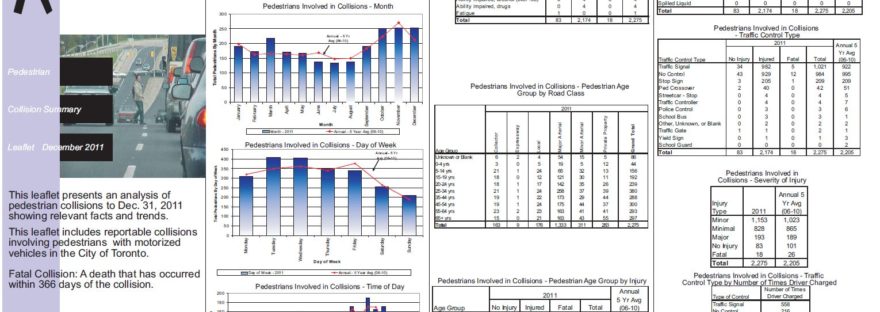The City of Toronto has a wide range of policies related to walking, but it’s not always easy to know about them or to find them. This post provides a convenient list of links to these various policies, so that anyone who is interested can get an overview what the City is doing, or at least says it should be doing, to improve the pedestrian experience in Toronto.
List revised in February 2014 to update links to new City of Toronto website, and links are added as they become available–last update March 2023.
- City of Toronto Walking Portal (links to policies and programs)
- Toronto Pedestrian Charter (2002)
- Toronto Walking Strategy (2009)
- Vision Zero Dashboard
- Street Furniture Program
- Vibrant Streets Guidelines (PDF) (includes street furniture placement guidelines)
- City of Toronto Accessible Streets portal
- Accessibility Design Guidelines (PDF)
- Streetscape Manual
- Complete Streets Guidelines
- Traffic Calming Policy
- Neighbourhood Streets Plans
- Rules for Crossing the Street – Jaywalking – Pedestrian Traffic Signals (goes to Internet Archive page as original deleted)
- Wayfinding Strategy
- Toronto Seniors Strategy
- Toronto Public Health: Walk to School
- Toronto Public Health: Walk into Health
- “Pedestrian and Cycling Safety in Toronto” (PDF) (Toronto Public Health report, 2015)
- “Active City: Designing for Health” (PDF) (Toronto Public Health report, 2014)
- “The Walkable City: Neighbourhood Design and Preferences, Travel Choice and Health” (PDF) (Toronto Public Health report, 2012)
- “Road to Health: Improving Walking and Cycling in Toronto” (PDF) (Toronto Public Health report, 2012)
- “Multi-Use Trail Design Guidelines” (PDF) (Toronto Transportation Services, December 2014)
- Traffic Signal FAQs
- List of walks offered in Toronto (also for adding walks to this list)
- Pedestrian Collision Statistics, 2000-2012 (reports formerly on City of Toronto website)
- Pedestrians killed or seriously injured (open data dashboard), 2007-present
- Road Safety page (includes links to yearly collision summaries)
- Toronto sidewalk inventory
- Community-led Street Event Guidelines (PDF) (How to close your local street for a street festival)
- Sidewalk
- Clearing snow and ice from your property (Transportation Services)
- PlowTO (has a layer that tracks sidewalk snowplows)
- Bylaw enforcement – snow and ice removal – snow clearing from sidewalks (311 Toronto)
- “Preventing Injuries from Wintertime Slips and Falls in Toronto” (Toronto Public Health report, PDF)
- City of Toronto Walking Habits and Attitudes Report (April 2013) (PDF)
- City of Toronto Sidewalk Inventory (open data)
- Report a traffic infraction to police (Citizen Online Report Entry (CORE))
- City of Toronto Pedestrian Network (pednet) dataset (walk times to amenities)
- Walking Tours (self-guided tours, from the City of Toronto)
- Map of Toronto sidewalk widths and another map of Toronto sidewalk widths
- Toronto Public Art Map
- StreetARToronto map of street art
- StrollTO – points of interest for walks in each of Toronto’s 25 wards
- Map of Privately Owned Public Spaces (POPS) (where pedestrians have access across private property)
- Traffic Volumes at Intersections – City of Toronto Open Data
- Online Pedestrian / Cyclist Collision Reporting Form
- City of Toronto missing sidewalks project (with list of current and upcoming projects)
Various non-municipal organizations also provide useful information about walking policy and programs:
- Metrolinx walk-to-school strategy
- Chief Coroner of Ontario Pedestrian Death Review (PDF)
- The Centre for Active Transportation (independent work on walking and cycling policy)
- Friends and Families for Safe Streets
- Jane’s Walk Toronto
- Jane’s Walk/University of Toronto Suburban Walkability Studies, “Walkability in Toronto’s Apartment Neighbourhoods” by Jane Farrow and Paul Hess: Executive Summary (PDF), Full Report (PDF), Workshop Report, Kingston-Galloway-Orton Park (PDF)
- Active and Safe Routes to School
- 8-80 Cities
- Pedestrian and Cyclist Death Rates: a Comparison between several Major Cities, by Ian Dennis Miller (2016)
- Road Safety: Crosswalks + Pedestrian Crossovers from law firm McLeish Orlando.
- METRAC safety audits

